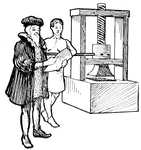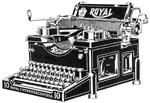Clipart tagged: ‘machines’

Archime' dean Screw
A cylinder with a triple threaded screw in a water tight case that revolves ater to the top for the…

Friction Coupling for Various Speed Adjustment
"The large driving cone J is hollow, the smaller or driven one convex. The latter presses, when desired,…
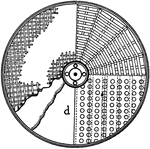
Cyanide Leaching Tank (Gold Extraction)
In the gold extraction process, finely crushed ores are leached in vats with a very diluted solution…
Balance, Dynamometer
"Balance-dynamometer (elevation). An apparatus for measuring the amount of force expended by men, animals,…

Balance, Dynamometer
"Balance-dynamometer (elevation). An apparatus for measuring the amount of force expended by men, animals,…
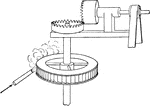
Steam Rotary Engine
An illustration of a rotary steam engine. The steam turbine system was invented by Branca in 1629. Steam…

Escapement
The contrivance in a time-piece which connects the wheel-work with the pendulum or the balance, giving…
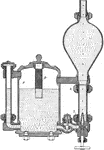
Automatic Feeder for Lubricating Materials
An automatic lubrication system often referred to as a centralized lubricator comprises a controller,…

Frue Vanner (Side View)
A Frue Vanner is a shaking, rubber belt used to concentrate gold ore 'pulp'.

De Laval Steam Turbine Connected to Generator
A De Laval steam turbine connected to a generator. The turbine generates electricity by turning the…

Pearsons Turbine for Electricity Generator
A cross sectional view of the Pearsons turbine for generating electricity. The turbines, located in…
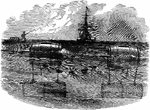
Infernal machine
"Infernal machine designed by the Confederates to destroy the Federal Flotilla in the Potomac discovered…

Roving Process in the Manufacturing of Jute
After being drawn through the drawing frames during the manufacturing process, the jute slivers are…

Lathe, Wood Turning
A lathe for turning wood to create a hole by fastening the material on to the faceplate.
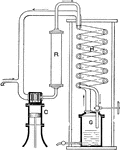
Air Liquefaction Machine
"After thorough drying, the air to be liquefied enters through the pipe a, and in the compresor C is…

Ammonia and Water Cycle Absorption Machine with Condenser and Tank
An absorption machine with ammonia and water mixing. The generator B heats the ammonia and water mixture…
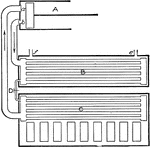
Ammonia Cycle Compression Machine with Vaporizer and Condenser
An illustration of a compression machine. As piston A is pushes ammonia gas through the condenser B…
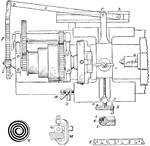
Turning Volute or Flat Spiral Machine
A volute or flat spiral turning machine. The spiral patterns are created by cutting the wood adjusting…
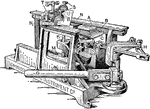
Large Sliding Microtome for Slicing Microscope Samples
A large sliding microtome is used to thinly slicing materials. Materials are sliced by placing the sample…
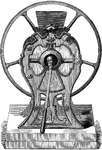
Mill
This mill was manufactured in Birmingham, England. It was possibly used as a textile mill for processing…
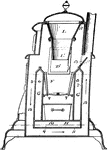
Wave Motor
Wave motors were machines designed and built in the late 19th and early 20th century to harness the…
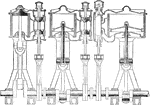
Piston of a Triple Expansion Steam Engine
A piston diagram from a triple expansion steam engine. The three cylinders are designed at high, medium,…
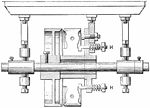
Loose Driving Pulley
"The belt is thrown on to set the machine in motion, the loose pulley is pressed aside by the spiral…

Direct Acting Steam Pump
"The direct—acting steam pump has the steam piston at one end of a rod and the water position…

Application of Steam Engine Jet Condenser used to Pump Well Water
An illustration showing the application of a jet condenser to pump a well. The steam enters the engine…
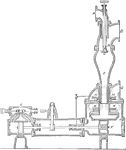
Steam Engine Jet Condenser with Pump
A sliced view of a jet condenser with pump. The steam enters at D, while cold water enters at A. The…
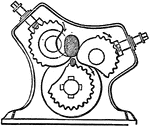
Revolving Squeezer
"Brown's revolving squeezer, the ball being made to pass between two rotating cams which flatten it…
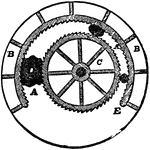
Revolving Squeezer
"Brown's revolving squeezer, the ball being made to pass between two rotating cams which flatten it…

Pneumatic Belt Shifter
"A pneumatic shifter moves the belt rapidly in either direction, holds it where it is put, and stays…

Hot Blast Smelting Furnace
"Smelting is the act or process of obtaining metal from ore by the combined action of heat, air, and…

Stamp Mill for Gold Ores (Sectional View)
A stamp mill facilitates the crushing of ore (in this case, gold ore) into very small grains, with many…

Steam Engine Condenser with Pumps
An illustration of the water entering and exiting the condenser through pump. The cooling water enters…

Cross Compound Steam Engine
Illustration of a cross compound steam engine. The engine is designed to hold pressure until the engine's…
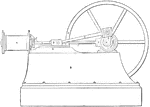
Low Power Simple Steam Engine Diagram
A low power steam engine. The piston inside cylinder A moves the wheel, generating power at 100 horsepower…

Low Power Simple Expansion Steam Engine
A low power simple expansion steam engine. The steam engine can run at 100 horsepower, and not run continuously.…
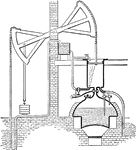
Newcomen Atmospheric Steam Engine
An illustration of Newcomen atmospheric steam engine. The boiler heats the water to build up steam in…
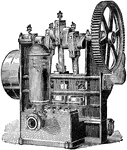
Power Pump Steam Engine
A power pump steam engine without shaft. The engine turns the wheel with the reciprocal motion of the…

Pulsometer from Steam Engine
"A modification of Savery's engine, the pulsometer, is still quite common. It is used in places where…
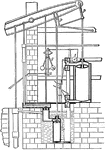
Watt's Final Steam Engine Design
The illustration showing Watt's final steam engine design. The engine is fitted with series of rods…

De Laval Steam Turbine
A De Laval steam turbine. The turbine is operated by supplying steam into the four nozzles. The steam…

Two Vessels from Thomas Savery First Steam Engine
Two vessels from the Thomas Savery first steam engine. The right tank fills up with water while the…

Water Tower Condenser Steam Cooling System in Engine Room
A diagram illustrating cooling steam exhaust of steam engine using a water tower. The water is pumped…
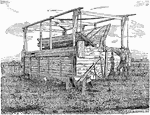
Homemade Jumbo Windmill
"Devices for lifting water are older than written history, and various forms of pumps are used on almost…




